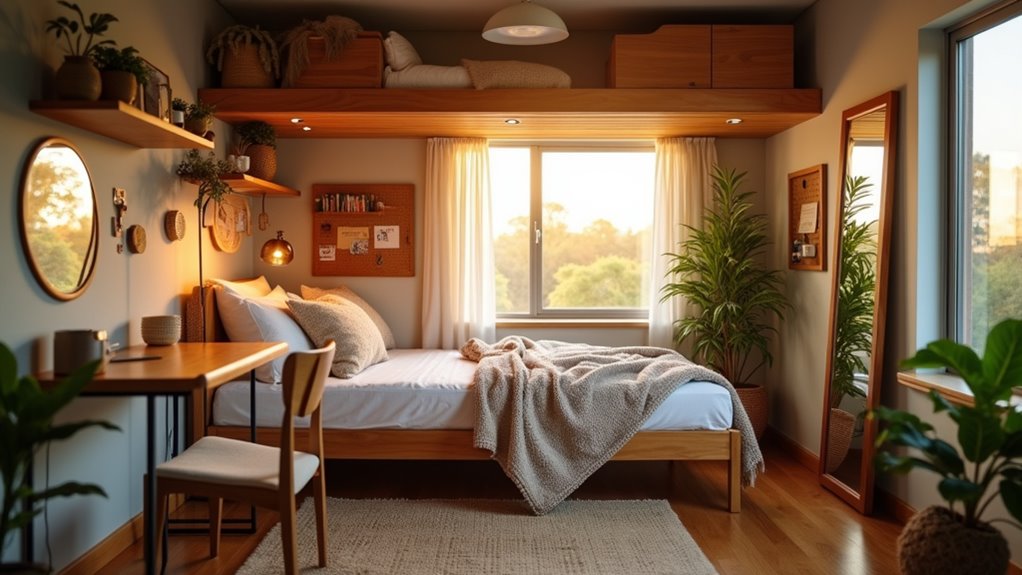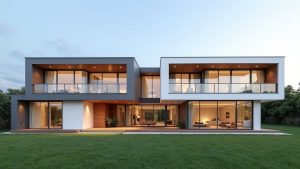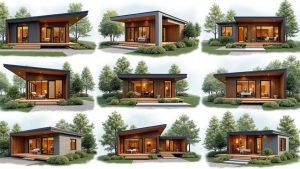Smart storage frees floor space with wall shelves, pegboards and clear labeled bins, while multipurpose furniture like ottomans and fold-away beds adds function without clutter. Layered lighting—dimmable ambient, focused task lamps and small accent fixtures—creates warmth and visual depth. Soft textiles, rugs and throws introduce texture and sound dampening. A restrained, consistent palette with a single bold focal piece preserves openness. Vertical plants and narrow personal displays finish the room, and further practical tips follow ahead.
Key Takeaways
- Use multifunctional furniture (beds with drawers, storage ottomans, fold-away desks) to save floor space and reduce clutter.
- Layer ambient, task, and accent lighting with dimmers to create warm, adjustable moods.
- Choose a restrained light palette with one bold focal piece to expand perceived space while adding personality.
- Maximize vertical storage—wall shelves, pegboards, slim coat rails—and label containers for easy access.
- Add soft textiles (rugs, throws, cushions) and one or two curated personal items to boost comfort without crowding.
Smart Storage Solutions to Declutter and Organize
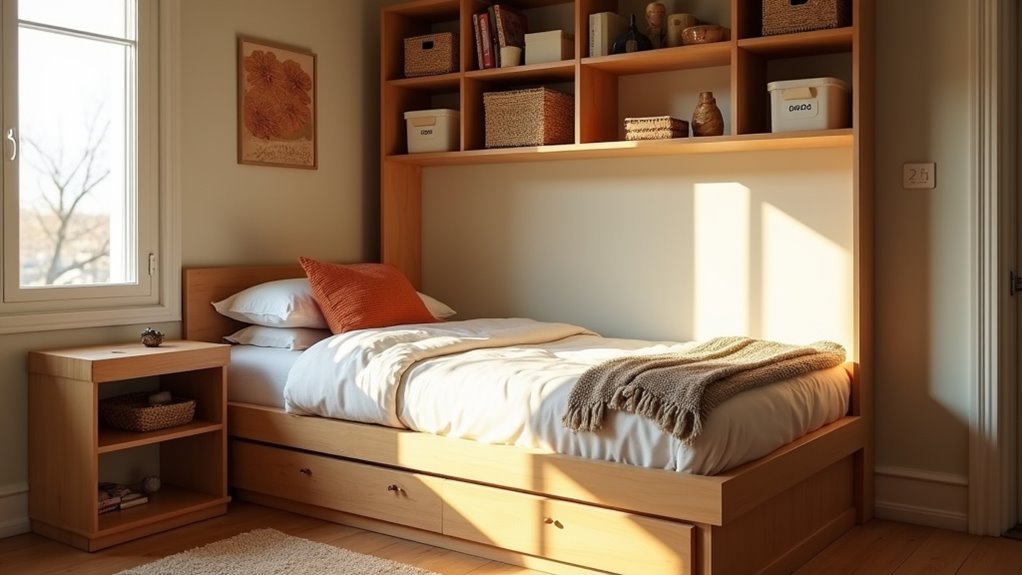
Although floor space may be limited, thoughtful storage transforms a small room into an orderly, functional area: maximize vertical surfaces with wall-mounted shelves and pegboards, choose multipurpose furniture like ottomans or beds with built-in drawers, and use clear, labeled containers to keep items visible and accessible.
Maximize vertical storage, pick multipurpose furniture, and use clear, labeled containers to keep small rooms neat and accessible.
The writer notes practical shelving options—floating shelves for display, adjustable units for changing needs, and cube systems that fit corners—emphasizing secure anchors and measured spacing.
Closet solutions focus on slim hangers, double rods, and hanging organizers to increase capacity without widening the footprint. Regular sorting routines and designated zones for daily items reduce clutter accumulation.
Thoughtful material choices and consistent labeling maintain clarity and make upkeep straightforward, preserving a calm, efficient small-room environment.
Multiuse Furniture for Flexible Living
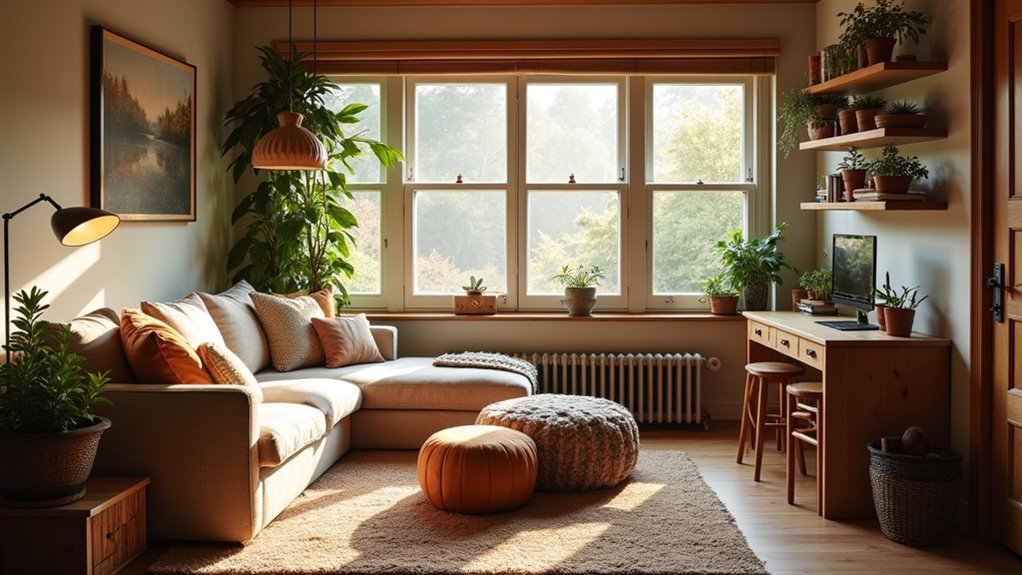
Multiuse furniture transforms tight layouts by combining functions—fold-away beds free floor space by night while becoming seating or storage by day.
Convertible seating, from sleeper sofas to ottomans with hidden compartments, offers adaptable comfort without adding clutter.
Modular storage units link or separate as needs change, allowing precise use of vertical and horizontal space.
Fold-Away Beds
When space needs shift from daytime productivity to nighttime rest, a fold-away bed converts a single footprint into two distinct functions without visual clutter. The piece emphasizes space saving designs that prioritize clear circulation paths, integrated storage, and easy access to linens.
Attention to adjustable frames ensures mattress support remains consistent whether vertical or horizontal, and mechanisms with quality dampers reduce noise and wear. Installation considerations include wall reinforcement, hinge alignment, and clearance for bedding and handles.
A minimalist facade—cabinet doors matching wall tones or shelving that doubles as a headboard—keeps the room cohesive. For small rooms, choosing standardized dimensions and serviceable hardware reduces maintenance.
Practical selection balances mattress comfort, mechanism reliability, and the room’s daily activity patterns.
Convertible Seating
Many small rooms gain outsized functionality from a single piece of convertible seating that shifts between sofa, lounger, guest bed, and storage unit as needed.
The discussion focuses on practical choices: compact frames with easy-release mechanisms, low-profile futons that unfold smoothly, and sectional pieces whose chaise converts into a daybed.
Dual purpose designs that include hidden compartments or under-seat storage reduce clutter while keeping essentials accessible.
Upholstery choices favor durable, stain-resistant fabrics in neutral tones to prolong wear and visually expand a space.
Small-scale armchairs with pull-out ottomans serve as occasional beds without dominating the floor plan.
Stylish stools that nest or double as side tables add seating flexibility and can be redistributed for guests.
Measurements, weight limits, and maintenance considerations guide selection.
Modular Storage Units
Modular storage units transform tight layouts by combining configurable shelving, concealed drawers, and surface space into systems that adapt as needs change.
Designed for multiuse living, they permit reconfiguration—stacking cubes, sliding panels, or swapping bins—to suit seasonal items, workstations, or entertaining.
Attention to scale and proportion prevents visual clutter: narrow vertical modules preserve floor area while low-profile units double as seating or display.
Materials and finishes matter; matte finishes and consistent tones maintain calm, whereas open modular shelving offers quick access for frequently used objects.
Function-driven details—soft-close drawers, adjustable shelves, integrated cable channels—improve daily use.
With deliberate placement and measured capacities, modular storage supports clear circulation, efficient organization, and meaningful space optimization in compact rooms.
Layered Lighting to Create Warmth and Depth
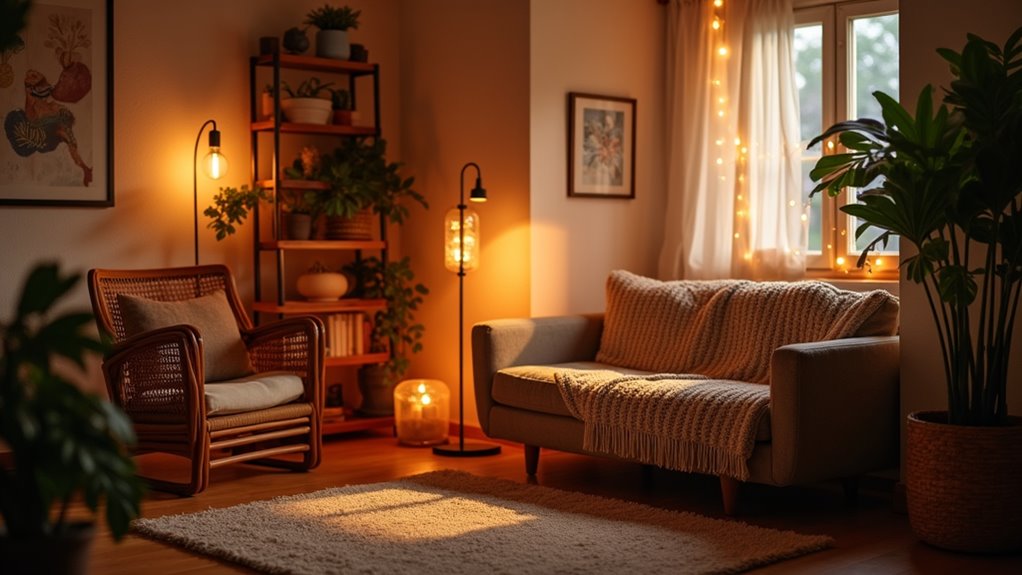
Layered lighting combines ambient, task, and accent sources to shape a small room’s perception of warmth and depth.
The approach begins with soft ambient light—dimmable ceiling fixtures or concealed LEDs—that provides even illumination and supports mood enhancement without glare. Task lighting is added selectively: adjustable desk lamps, under-shelf strips, or a bedside swing arm for focused activities.
Accent fixtures introduce depth through wall washers, picture lights, or low-level floor lamps that cast upward pools and highlight texture.
Placement and color temperature matter: warm (2700–3000K) sources unify the scheme while varying intensities create visual hierarchy.
A practical plan uses three control points (general, task, accent) on dimmers or smart controls, allowing layered scenes that optimize comfort and perceived spaciousness.
Soft Textiles for Instant Coziness
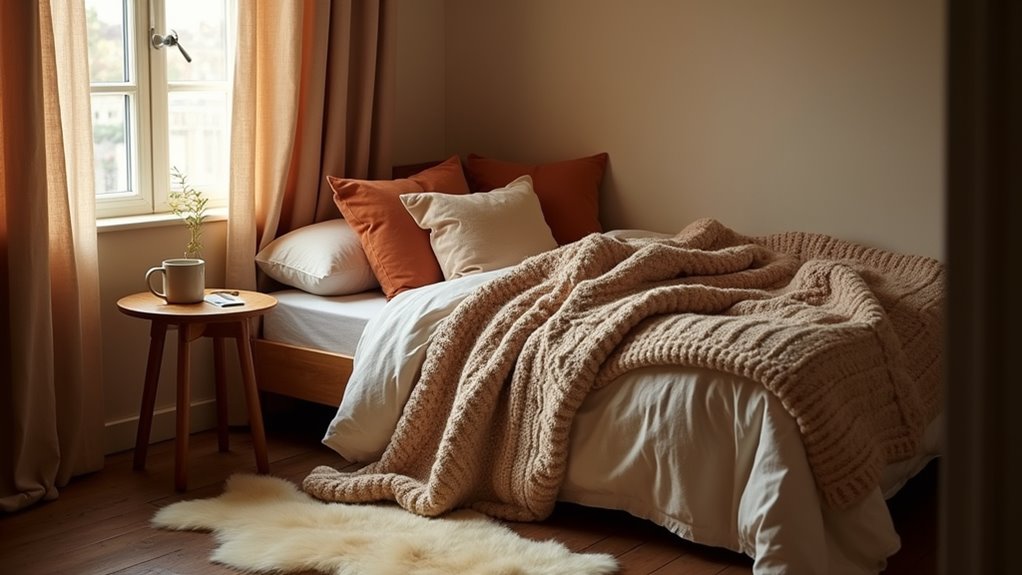
A stack of layered blankets and throws provides immediate texture and functional warmth, allowing occupants to adjust comfort by season or activity.
A plush rug underfoot anchors seating areas and muffles sound, making small spaces feel both warmer and more intimate.
Attention to material and pile height ensures these textiles perform well in tight layouts without overwhelming the room.
Layered Blankets and Throws
Three blankets of different weights and textures — a lightweight cotton, a midweight wool, and a chunky knit throw — provide immediate warmth and visual depth without crowding a small room. Arranging them with one folded at the foot of the bed, one casually draped across a chair, and one layered diagonally on the sofa balances function and form while keeping pathways clear and surfaces usable.
The strategy focuses on intentional blanket layering: mix neutral bases with one patterned or colored piece to anchor the palette. Prioritize accessible storage like a slim basket or wall hook to rotate seasonal pieces.
Attention to throw textures ensures tactile contrast—smooth, nubby, and lofty—so each layer reads distinctly and remains easy to grab for comfort.
Plush Rugs Underfoot
Place a plush rug where feet land most—beside the bed, under a sofa, or at an entry—to anchor the space and deliver immediate tactile comfort.
The writer recommends selecting rug materials with intent: wool for resilience and warmth, cotton for easy care, or synthetic blends for stain resistance.
Size and placement matter—extend a rug at least 18 inches beyond furniture edges to create cohesion without overwhelming a small room.
Pile height affects underfoot comfort; a mid- to high-pile balances softness and maintenance.
Layering a smaller textured rug over a flatweave adds visual depth and grip.
Consider non-slip pads to protect flooring and preserve rug shape.
Regular vacuuming and spot care keep fibers lofted, maintaining both look and long-term comfort.
Strategic Color Palettes to Open Up Space
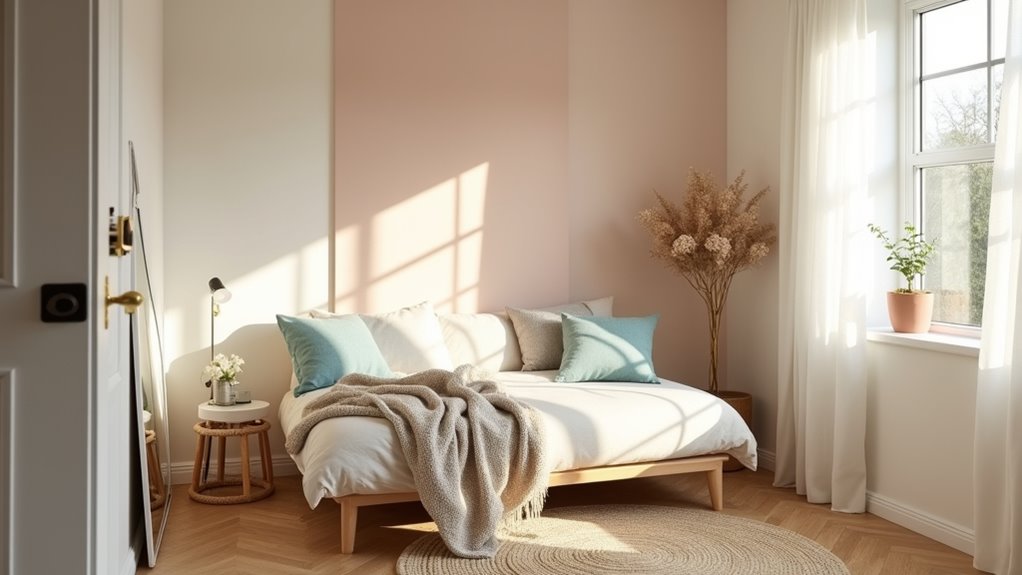
When natural light is limited, choosing a restrained palette of cool neutrals and pale, warm whites can visually push walls outward and raise perceived ceiling height. Accent hues should be used sparingly and low on the vertical plane—on furniture, rugs, or baseboards—to maintain depth without chopping the space.
The approach favors airy whites and light color foundations paired with warm neutrals to retain coziness. Monochromatic schemes simplify sightlines; subtle shifts in tone create layered interest without clutter.
Soft pastels work for textiles and small decor, while earth tones anchor seating or shelving. Bold statements are best reserved for a single focal piece to avoid overwhelm. Measured contrast and consistent undertones ensure the room reads larger and remains inviting.
Vertical and Wall-Mounted Elements to Save Floor Area
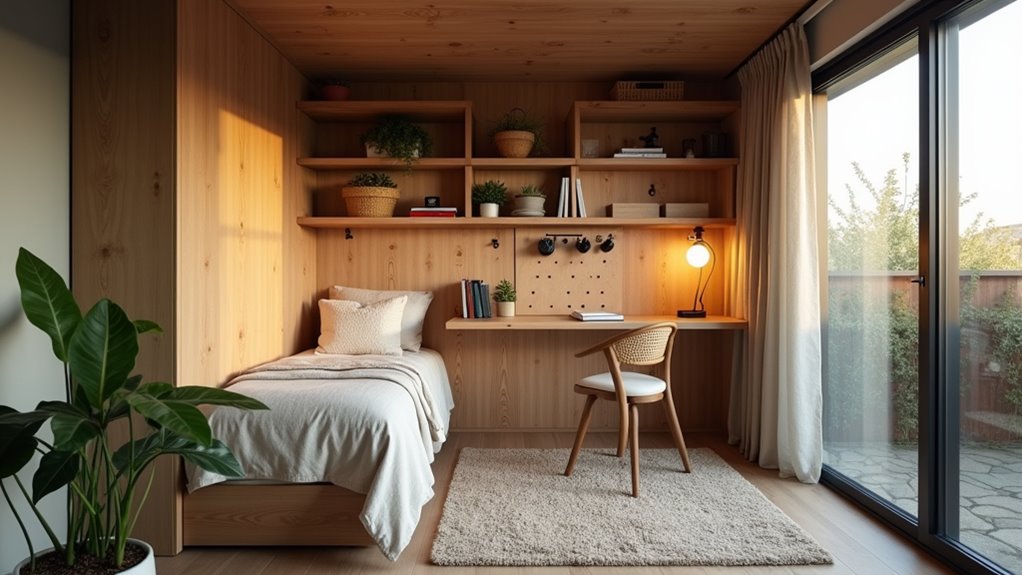
Vertical storage and wall-mounted fixtures reclaim valuable floor space by shifting functions upward: tall, narrow shelving units, floating cabinets, and wall-hung desks concentrate storage and work areas along the walls, freeing walkways and seating zones.
A practical plan layers needs vertically—closed wall shelves for clutter, open shelves for display, and a slim coat rail or pegboard near the entry.
Integrating vertical gardens adds greenery without sacrificing footprint; choose shallow-planter systems or modular pockets for easy watering.
Lighting mounted above or under shelves preserves surfaces while improving task visibility.
Hardware should be anchored to studs and rated for load.
Prioritize multifunctional mounts like fold-down desks and recessed niches to maintain clean sightlines and maximize usable floor area in a compact, efficient layout.
Personal Touches and Small-Scale Decor to Make It Yours
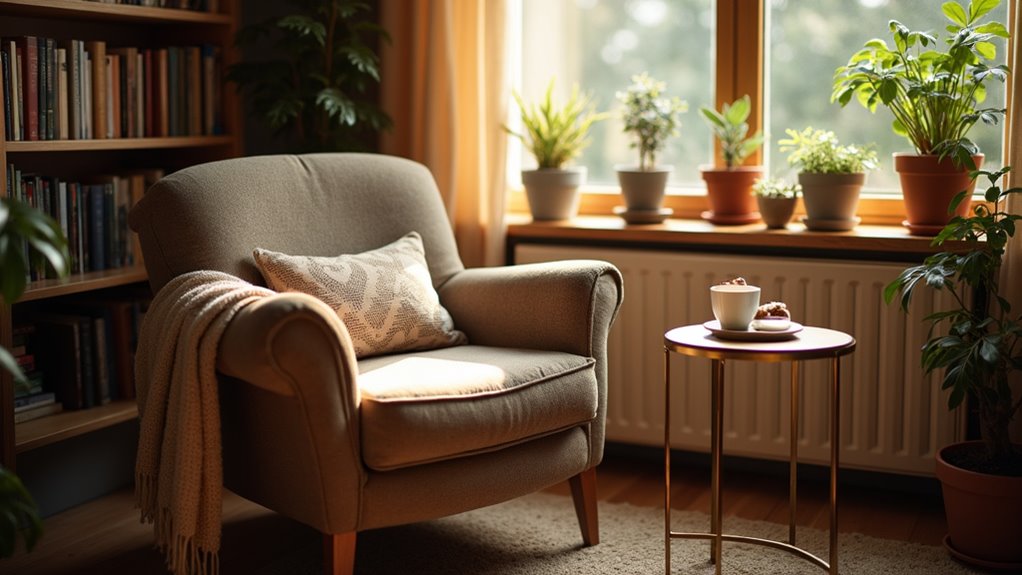
A few well-chosen personal touches transform a compact room from merely functional to distinctly lived-in, using small-scale decor that respects limited space while reflecting individual tastes.
The writer recommends grouping personal mementos on a narrow shelf or in a shallow shadowbox to prevent clutter while preserving sentimental value. Curated artwork should be limited to one or two focal pieces sized proportionally to the wall; a slim frame or canvas keeps visual weight light.
Functional accents—a textured throw, decorative tray, or small plant—add warmth without sacrificing circulation. Lighting choices, such as a directional wall sconce or clip lamp, highlight objects and create layers.
Consistent color accents and restrained patterns unify the scheme, ensuring each item contributes to comfort and purpose.


